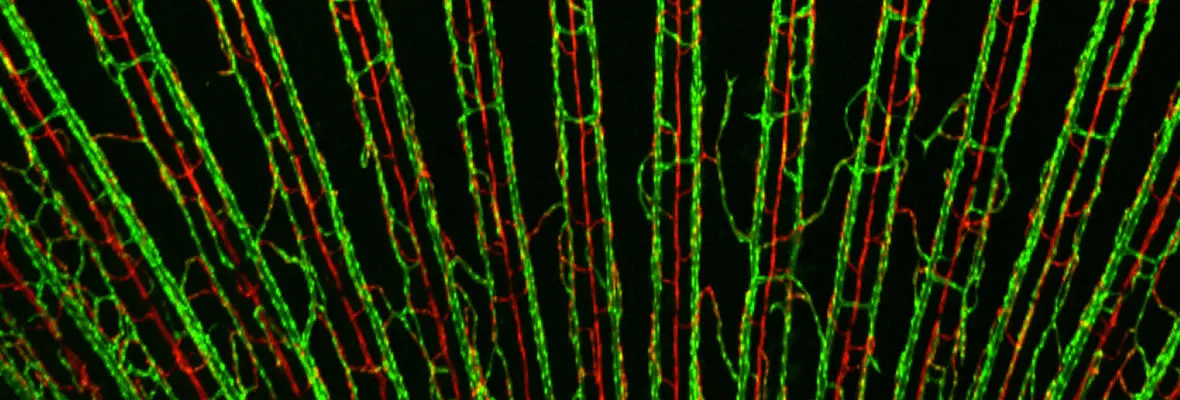Home
We are using zebrafish to investigate the mechanisms controlling blood vessel formation during embryonic development and tissue regeneration. The focus of our work lies on understanding the morphogenetic principles responsible for the growth of hierarchically patterned blood vessel trees and how mechanical forces exerted by the flowing blood influence genetic programs controlling cellular differentiation.
Research Overview
Our work aims at understanding the mechanisms that lead to the correct formation of the intricate networks of blood vessels within our bodies. These networks are vital for proper organ function and tissue homeostasis. Consequently, blood vessel defects can lead to serious illnesses and contribute to stroke and cardiovascular disease. We are interested in identifying the genes that cause blood vessels to properly grow in developing embryos and how tree-shaped hierarchically patterned blood vessel networks can arise. In particular, we are investigating how the forces exerted by the flowing blood influence the biology of individual cells that build blood vessel networks. We are also fascinated by the question how different kinds of blood vessels, such as arteries and veins, arise. These are different in their makeup and it is not understood which mechanisms might control their differentiation and subsequent maturation.
Research Focus
One fundamental aspect of growing blood vessels is the necessity to build functional networks, in which blood can flow from the heart into our bodies and back to the heart. The blood vessels that carry blood away from heart are called arteries, while those returning the blood to the heart are called veins. Between arteries and veins lies a network of very small vessels, the capillaries. One research focus of our laboratory is to understand what factors guide the formation of arteries. We were able to directly visualize using live imaging how newly forming arteries develop during tissue regeneration in adult zebrafish. Here, we found that veins are the source of new arterial cells and that some vein-derived cells undergo specific migratory behaviors that allow them to connect to pre-existing arteries. We also identified a chemokine receptor, cxcr4, that is important to coordinate these cell migration behaviors. In subsequent work, we investigated the signaling pathways controlling cxcr4 expression and found that Notch signaling is necessary to modulate cxcr4 expression and thereby influence cell migration. We achieved this by directly imaging Notch pathway activation in newly forming blood vessels. Our work has therefore helped to better understand how new arteries form and how arteries and veins can appropriately connect to each other.
In addition to their proper connectivity, newly forming blood vessels also need to acquire distinct sizes to allow for efficient blood flow patterns. Most vascular beds are arranged in a hierarchical manner, resembling the shape of trees. We study how these tree-shaped patterns can arise. We found that endothelial cells (the cells lining blood vessels) change their shapes in response to the magnitude of the blood flowing through them. They become more elongated, thereby decreasing blood vessel diameters. These changes were impaired in a zebrafish mutant for the endoglin gene, a co-receptor for bone morphogenetic pathway ligands. Of importance, endoglin mutations can cause a human disease condition, called hereditary hemorrhagic telangiectasia (HHT). Therefore, our studies not only shed light on blood vessel size control, but might also provide the foundation for new HHT therapies.
Future Research Directions
We are currently investigating what molecules work together with cxcr4 and endoglin to control endothelial cell migration during artery formation and blood vessel size control, respectively. In the future, we are aiming at an understanding of the regulation of gene expression in response to the forces that blood flow exerts on endothelial cells. We already found that cxcr4 expression is dependent on blood flow and that endoglin affects cell shapes only in situations when endothelial cells experience forces exerted by the flowing blood. How cells interpret these forces is not understood. In an effort to gain insights into this regulation, we are investigating the epigenetic changes that occur in response to hemodynamic forces and how these might control gene expression patterns. We are also focusing on identifying the transcription factors and their binding sites that are important for controlling gene expression downstream of biophysical forces with the goal of mutating these binding sites in zebrafish. We foresee that understanding these regulations will also help in deciphering the mechanisms causing human cardiovascular diseases, as many of the genomic changes associated with disease are thought to be located within regions regulating gene expression.


